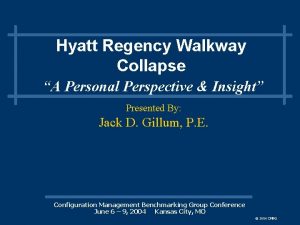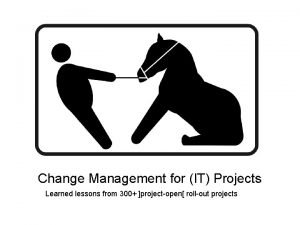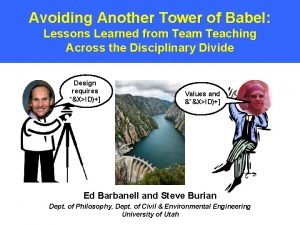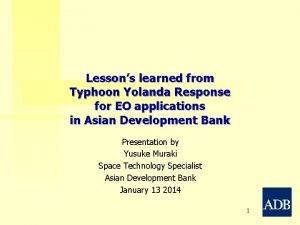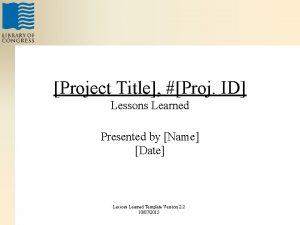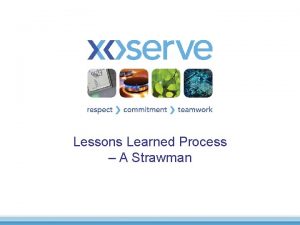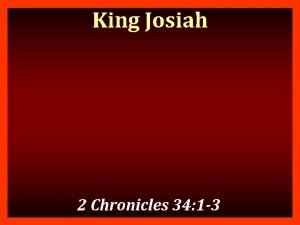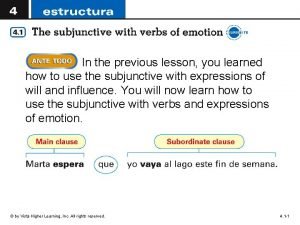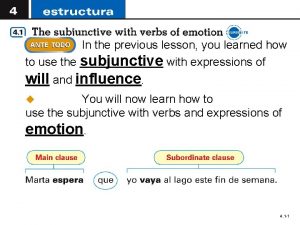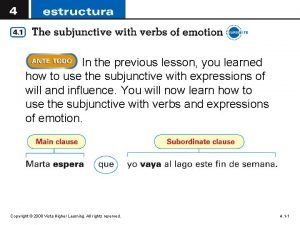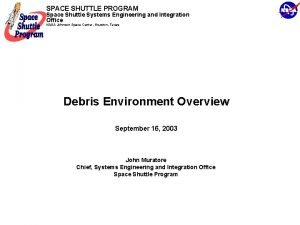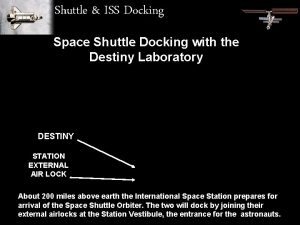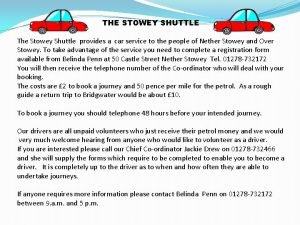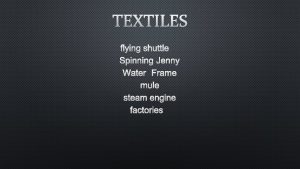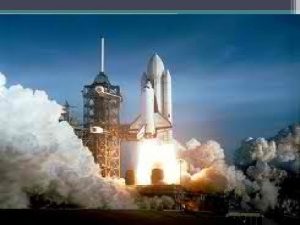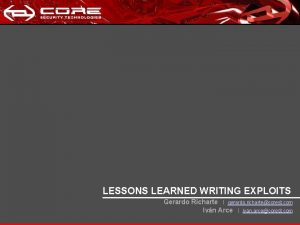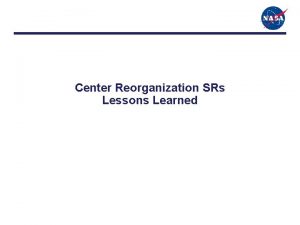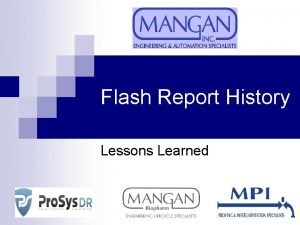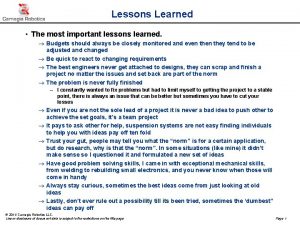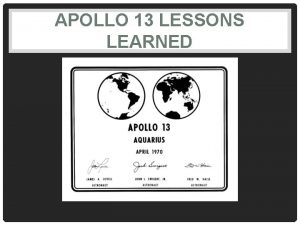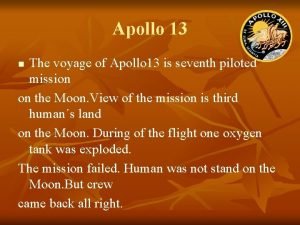Lesson 4 Selected Apollo Shuttle Lessons Learned Part

































- Slides: 33

Lesson 4: Selected Apollo & Shuttle Lessons Learned (Part 1) 1

Objectives • Identify Apollo program pressure vessel failures lessons learned • Identify Shuttle program thermal protection system failures lessons learned 2

Lesson 4: Selected Apollo & Shuttle Lessons Learned (Part 1) • Mr. Bud Castner • Mr. Glenn Ecord 3

Introduction • Materials durability is critical when dealing with pressure vessels • Pressure vessels store fluids at pressures above atmospheric – High stored energy usually involved – Hazardous chemicals often involved • High pressures & hazardous fluids heighten sensitivity to damage modes – – – Stress corrosion cracking Fatigue cracking Embrittlement mechanisms Small defects Others • Damage modes have potential to cause serious, even catastrophic failures 4

Apollo Reaction Control System (RCS) Oxidizer Tank Failures • RCS was propulsion system used to provide spacecraft with maneuvering ability along all 3 axes • RCS rocket engines used hypergolic propellants – Oxidizer: nitrogen tetroxide (N 2 O 4) – Fuel: Aerozine 50 • RCS oxidizer tank design – – Material: titanium alloy 6 Al-4 V (Ti-6 Al-4 V) Environment: N 2 O 4 Configuration: cylinder, 12" diam. , 18" long, 0. 020" thick Usage: 12 total in Command, Service & Lunar Modules 5

RCS Oxidizer Tank Failures (cont. ) • RCS oxidizer tank exploded in test, January 1965 – Occurred on 23 rd day of 30 -day creep test – Failure analysis indicated SCC • Fingerprint • Surface contamination • 10 additional oxidizer tanks in test, July 1965 – 4 exploded in first 42 hours – 4 others leaked – SCC indicated • All prior experience indicated compatibility – Gemini, Lunar Surveyor, Titan missile – No contrary historical data – Other recent specimen & tank tests verified compatibility • Confusion reigns PM 4 -4 – Previously compatible system now incompatible – Large inventory of tanks already on hand 6

Investigation Results • Round robin testing identified problem – – – Tank manufacturer failed everything tested Prime contractor cannot fail specimens or tanks N 2 O 4 samples exchanged among test labs Color difference noted in exchanged samples Color difference due to nitric oxide (NO) content • Supplier of N 2 O 4 removed trace amounts of NO starting in June 1964 – – Small change made N 2 O 4 highly damaging to titanium No requirement in N 2 O 4 specification regarding NO content No clues at start of investigation that NO content mattered Tank manufacturer using new “improved” oxidizer 7

Damage Mode Stress Corrosion Cracking PM 4 -6 8

RCS Tank Failure Solutions • Restored original N 2 O 4 chemistry – Added back small amount of NO to oxidizer – Generated NASA specification requiring 0. 5% NO • Verified fix with many specimen & tank tests • Tested propellants before each launch 9

RCS Oxidizer Tank Lessons Learned • Minor process “improvement” voided all prior compatibility testing • No such thing as small change • Safety factors impact durability – Low safety factors increase susceptibility to damage modes – Low safety factors can change compatibility to incompatibility • Must establish Kth for all fluids that contact tank while pressurized 10

Apollo Service Propulsion System (SPS) Fuel Tank Failures • SPS was propulsion system that provided spacecraft with large velocity-change capability • SPS used same hypergolic propellants as RCS – Oxidizer: nitrogen tetroxide (N 2 O 4) – Fuel: Aerozine 50 • SPS fuel tank design – Material: Ti-6 Al-4 V – Environment: Aerozine 50 (methanol used in cold flow test) – Configuration: cylinder, 4 ft diam. , 14 ft long, 0. 055" thick – Usage: 2 in Service Module PM 4 -9 11

SPS Fuel Tank Failures (cont. ) • Oct. 1, 1966: SC-101 fuel tank leaked during cold flow test – Methanol used in place of Aerozine 50 – Suspected stress corrosion cracking – Weld contamination also suspected • Additional tank testing instituted to sort out SCC & weld contamination possibilities – Tanks to be tested in place – Tank considered to be a leaker • Oct. 25, 1966: SC-017 fuel tank exploded during test – Tank installed in Service Module when tank exploded – SC-017’s Service Module completely destroyed in explosion PM 4 -11 12

Underlying Problem: Methanol • Methanol used as referee fluid for Aerozine 50 in cold flow test – – Considered innocuous Less hazardous than fuel Similar specific gravity & flow characteristics to fuel Considered compatible with titanium • Used reagent-grade methanol in test – Anhydrous (low water content) – Low-water-content methanol very aggressive to titanium • Damage mode: stress corrosion cracking 13

Investigation Results Constant Load Data Shows extreme stress corrosion sensitivity of anhydrous methanol compared to fuel & distilled water PM 4 -11 14

SPS Tank Failure Solutions • Stopped using methanol as referee fluid • Scrapped all tanks that had been through cold flow test • Applied fracture mechanics methodology to all pressure vessels in remainder of Apollo Program – Proof-test logic principally used • Many tanks already in inventory • Low number of cycles involved – Measured fracture toughness, fatigue & environmental crack growth properties of all tank materials • Parent, weld & HAZ • Measured Kth of actual flight propellants before each lunar mission 15

SPS Tank Lessons Learned • Small chemical changes can have profound effect on durability • Even environments considered innocuous cause stress corrosion • Must establish Kth for all fluids used as pressurants 16

S-IVB Helium Pressurization Tank Failure • Helium tanks pressurized IVB LOX & LH 2 tanks • Helium tank design S- – Material: Ti-6 Al-4 V – Configuration: spherical, 27" diam. , 0. 333" thick – Usage: 12 per S-IVB stage • S-IVB stage – Third stage of Saturn V – 20 ft diam. × 40 ft long – LOX/ LH 2 propellants • S-IVB 503 stage was scheduled for Apollo 8 (1 st manned circumlunar mission) PM 4 -12 17

S-IVB Helium Pressurization Tank Failure (cont. ) • Static firing part of S-IVB stage acceptance test • Began simulated launch countdown Jan. 20, 1967 • Without warning, S-IVB exploded in enormous fireball – – – Occurred at T 0– 11 seconds Stage completely destroyed Static firing test stand substantially damaged 300 -ft fireball observed Offsite damage reported 12 miles away • Observers saw flashes in aft skirt region prior to explosion • Subsequently determined helium tank exploded first – Found helium tank halves in debris – Brittle fracture along weld fusion line 18

S-IVB Helium Pressurization Tank Failure (cont. ) Explosion destroyed entire S-IVB stage & severely damaged static firing test stand PM 4 -14 19

Underlying Problem • Tank welded with wrong weld wire – Commercially pure (CP) titanium weld wire used – One spool of CP wire was mislabeled/misshelved – Specification called for titanium 6 Al-4 V weld wire • Wrong wire resulted in low alloy content in the weld – – Much lower hydrogen solubility in weld Hydrogen diffused to weld via a stress gradient Hydrogen precipitated as titanium hydride needles at fusion line Over time sustained load cracking occurred • Very-low-alloy content resulted from multipass weld – 10– 12 passes required – Each pass further diluted weld deposit 20

Wrong Weld Wire Titanium hydride needles PM 4 -13 21

S-IVB Tank Failure Solution • Remove all helium tanks welded with CP weld wire – 5 on S-IVB 503 stage – 4 found on other stages • Spacecraft 6 Al-4 V tanks implicated by problem – Welded on purpose with CP weld wire – JSC cut up many tanks looking for hydrides – No hydrides were found • Hydride problem peculiar to thick multipass welds • Spacecraft 6 Al-4 V tanks were thin-walled single/double pass welds 22

S-IVB Tank Lessons Learned • Mislabeled weld wire, i. e. , human error is a fact of life • Verify weld wire composition at start & stop of welding process 23

Apollo 13 Oxygen Tank Failure • Apollo 13 lifted off April 11, 1970, at 13: 13 pm CST – 00: 00 GET – – – – – 00: 12: 40 GET—Reached Earth orbit 02: 41: 47 GET—Translunar injection 05: 59 GET—S-IVB maneuver for lunar impact 55: 54: 20 GET—Oxygen tank explosion (200, 000 miles from Earth) 77: 27: 39 GET—Pericynthion 77: 56: 40 GET—S-IVB impacts lunar surface 138: 02: 06 GET—Service Module jettisoned 141: 30: 02 GET—Lunar Module jettisoned 142: 40: 47 GET—Entry interface • Apollo 13 landed April 17, 1970, at 12: 08 pm CST – 142: 54: 00 GET 24

Apollo 13 Oxygen Tank Failure (cont. ) • Supercritical oxygen tanks provided breathing oxygen to CM & reactant oxygen to fuel cells for electrical power • Oxygen tank design – Material: Inconel 718 – Configuration: spherical, 25" diam. × 0. 060" thick – Usage: 2 in Service Module • Internal components— 2 tube assemblies – Quantity gauge/fill tube – Heating element/stirring fans PM 4 -18 25

Underlying Problems • Tank contained: – Pure-oxygen environment – Flammable materials – Ignition sources • • • Thermostatic switches underpowered Switches not tested under power Tank dropped in manufacturing Could not detank after CDDT Improvised detanking procedure – No test/verification – Very high internal temperature occurred – Wire insulation severely degraded PM 4 -19 26

Cause of Accident • Not single cause but combination of mistakes & deficient, unforgiving design • Nature is unforgiving – Does not read our papers – Patient & the ultimate judge • Combination of mistakes – Higher-power (65 VDC) switches required in Block II tanks not incorporated – Switches never cycled under load in qualification or acceptance test – Tank dropped during manufacturing • • Bolt not removed Handling fixture broke Tank shelf dropped Fill tube jarred loose – Tank #2 cannot detank per procedure at KSC after CDDT – KSC improvised new detanking procedure • No test & verification 27

Cause of Accident (cont. ) • Improvised detanking procedure required prolonged heating of tank contents – Thermostatic switches set at 80 °F • Prolonged heating requires switches to open • First time ever with 65 VDC – 28 VDC switches opening with 65 VDC power applied weld shut • Opening arc persists too long • Contacts melt & bridge 0. 015" gap – Power to heating element on for 8 hours • Temperature near heating element 1, 000 °F • Teflon insulation on nearby wires severely degraded PM 4 -20, 4 -21 28

Explosion Sequence of Events • KSC-improvised detanking procedure created hazardous condition in tank 2 • Cryogen-stirring fans turned on (7 th time) at 55: 54: 20 GET – Bare wire exposed by degraded insulation shorted – Teflon wire insulation ignited • Rapidly rising temperature & pressure inside tank caused rupture of electrical conduit in tank dome area – Explosive release of high-pressure oxygen into Service Module electrical compartment – Extensive damage in compartment defeats all redundancies of 2 oxygen tanks & 3 fuel cells – Overpressure blows exterior panel off Service Module fuel cell compartment • Primary source of breathing oxygen & power generation lost 29

Apollo 13 Oxygen Tank Solutions • Major tank redesign – Removed all wiring & motors from contact with oxygen – Minimize use of flammable materials inside tank • Some felt installing correctly rated switch would be sufficient • Implemented rigorous requalification test program • Revised KSC prelaunch anomaly resolution procedure • Reassessed all subsystems & responsible organizations 30

Apollo 13 Lessons Learned • Failures not necessarily due to single cause • Qualification testing is space industry gold standard • Margin between success & failure can be very narrow • Randomness of event can make difference between success & failure • Even cryogenic oxygen environments can be flammability hazards 31

Summary • RCS oxidizer tank failure demonstrated that: – – Any change is important Qualification testing is extremely important Safety factors impact durability Engineers must establish Kth for all fluids • SPS fuel tank failure: – – Reinforced lessons learned in RCS oxidizer tank: small chemical changes & otherwise innocuous fluids can cause stress corrosion cracking Led to adopting fracture mechanics methodology for pressure vessels in remainder of Apollo program 32

Summary (cont. ) • S-IVB helium tank failure emphasized: – – Importance of verification of correct material usage Ever-present possibility of human error • Apollo 13 oxygen tank incident reiterated: – – Risks of oxygen-rich environments Importance of ‘test as you fly, fly as you test’ practice 33
 Lessons learned faa
Lessons learned faa Kansas city hyatt regency walkway collapse video
Kansas city hyatt regency walkway collapse video Change management lessons learned
Change management lessons learned Workday implementation lessons learned
Workday implementation lessons learned Mt carmel contest
Mt carmel contest Hydrotopia
Hydrotopia Lessons learned repository
Lessons learned repository Lessons learned suomeksi
Lessons learned suomeksi Typhoon yolanda lessons learned
Typhoon yolanda lessons learned Lessons learned ground rules
Lessons learned ground rules What lesson can we learn from ants
What lesson can we learn from ants Lesson in life of pi
Lesson in life of pi Tac lessons learned
Tac lessons learned Dps project title
Dps project title Lessons learned purpose
Lessons learned purpose Elijah and obadiah
Elijah and obadiah Lessons learned from king josiah
Lessons learned from king josiah 2 chronicles 34:1-3
2 chronicles 34:1-3 Pmbok lessons learned
Pmbok lessons learned Six sigma lessons learned
Six sigma lessons learned Nerc lessons learned
Nerc lessons learned Lessons not learned in blood
Lessons not learned in blood Lesson 8 review of lessons 5-7 answers
Lesson 8 review of lessons 5-7 answers The diamond necklace summary
The diamond necklace summary Lorax worksheet answers
Lorax worksheet answers In your previous lesson you
In your previous lesson you Account payable current or noncurrent
Account payable current or noncurrent In the previous lesson i learned that
In the previous lesson i learned that In your previous lesson you have learned
In your previous lesson you have learned In the previous lesson you learned how to express
In the previous lesson you learned how to express Lesson learned artinya
Lesson learned artinya Characteristics of research methodology
Characteristics of research methodology Survivorship curve for k selected species
Survivorship curve for k selected species Selected response assessment
Selected response assessment

